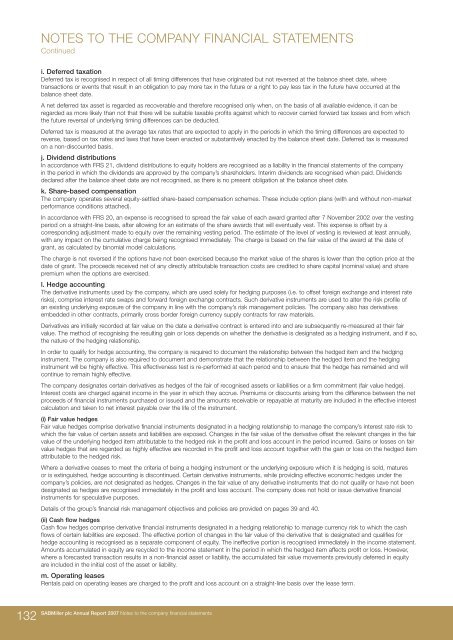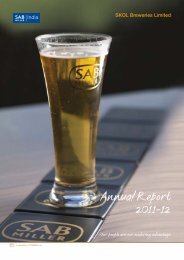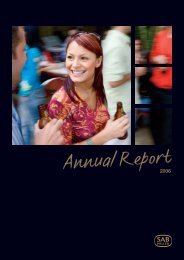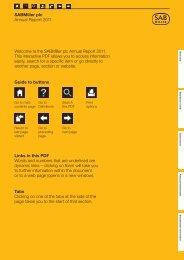Download the SABMiller plc 2007 Annual report PDF (3.70Mb)
Download the SABMiller plc 2007 Annual report PDF (3.70Mb)
Download the SABMiller plc 2007 Annual report PDF (3.70Mb)
- No tags were found...
Create successful ePaper yourself
Turn your PDF publications into a flip-book with our unique Google optimized e-Paper software.
NOTES TO THE COMPANY FINANCIAL STATEMENTSContinuedi. Deferred taxationDeferred tax is recognised in respect of all timing differences that have originated but not reversed at <strong>the</strong> balance sheet date, wheretransactions or events that result in an obligation to pay more tax in <strong>the</strong> future or a right to pay less tax in <strong>the</strong> future have occurred at <strong>the</strong>balance sheet date.A net deferred tax asset is regarded as recoverable and <strong>the</strong>refore recognised only when, on <strong>the</strong> basis of all available evidence, it can beregarded as more likely than not that <strong>the</strong>re will be suitable taxable profits against which to recover carried forward tax losses and from which<strong>the</strong> future reversal of underlying timing differences can be deducted.Deferred tax is measured at <strong>the</strong> average tax rates that are expected to apply in <strong>the</strong> periods in which <strong>the</strong> timing differences are expected toreverse, based on tax rates and laws that have been enacted or substantively enacted by <strong>the</strong> balance sheet date. Deferred tax is measuredon a non-discounted basis.j. Dividend distributionsIn accordance with FRS 21, dividend distributions to equity holders are recognised as a liability in <strong>the</strong> financial statements of <strong>the</strong> companyin <strong>the</strong> period in which <strong>the</strong> dividends are approved by <strong>the</strong> company’s shareholders. Interim dividends are recognised when paid. Dividendsdeclared after <strong>the</strong> balance sheet date are not recognised, as <strong>the</strong>re is no present obligation at <strong>the</strong> balance sheet date.k. Share-based compensationThe company operates several equity-settled share-based compensation schemes. These include option plans (with and without non-marketperformance conditions attached).In accordance with FRS 20, an expense is recognised to spread <strong>the</strong> fair value of each award granted after 7 November 2002 over <strong>the</strong> vestingperiod on a straight-line basis, after allowing for an estimate of <strong>the</strong> share awards that will eventually vest. This expense is offset by acorresponding adjustment made to equity over <strong>the</strong> remaining vesting period. The estimate of <strong>the</strong> level of vesting is reviewed at least annually,with any impact on <strong>the</strong> cumulative charge being recognised immediately. The charge is based on <strong>the</strong> fair value of <strong>the</strong> award at <strong>the</strong> date ofgrant, as calculated by binomial model calculations.The charge is not reversed if <strong>the</strong> options have not been exercised because <strong>the</strong> market value of <strong>the</strong> shares is lower than <strong>the</strong> option price at <strong>the</strong>date of grant. The proceeds received net of any directly attributable transaction costs are credited to share capital (nominal value) and sharepremium when <strong>the</strong> options are exercised.l. Hedge accountingThe derivative instruments used by <strong>the</strong> company, which are used solely for hedging purposes (i.e. to offset foreign exchange and interest raterisks), comprise interest rate swaps and forward foreign exchange contracts. Such derivative instruments are used to alter <strong>the</strong> risk profile ofan existing underlying exposure of <strong>the</strong> company in line with <strong>the</strong> company’s risk management policies. The company also has derivativesembedded in o<strong>the</strong>r contracts, primarily cross border foreign currency supply contracts for raw materials.Derivatives are initially recorded at fair value on <strong>the</strong> date a derivative contract is entered into and are subsequently re-measured at <strong>the</strong>ir fairvalue. The method of recognising <strong>the</strong> resulting gain or loss depends on whe<strong>the</strong>r <strong>the</strong> derivative is designated as a hedging instrument, and if so,<strong>the</strong> nature of <strong>the</strong> hedging relationship.In order to qualify for hedge accounting, <strong>the</strong> company is required to document <strong>the</strong> relationship between <strong>the</strong> hedged item and <strong>the</strong> hedginginstrument. The company is also required to document and demonstrate that <strong>the</strong> relationship between <strong>the</strong> hedged item and <strong>the</strong> hedginginstrument will be highly effective. This effectiveness test is re-performed at each period end to ensure that <strong>the</strong> hedge has remained and willcontinue to remain highly effective.The company designates certain derivatives as hedges of <strong>the</strong> fair of recognised assets or liabilities or a firm commitment (fair value hedge).Interest costs are charged against income in <strong>the</strong> year in which <strong>the</strong>y accrue. Premiums or discounts arising from <strong>the</strong> difference between <strong>the</strong> netproceeds of financial instruments purchased or issued and <strong>the</strong> amounts receivable or repayable at maturity are included in <strong>the</strong> effective interestcalculation and taken to net interest payable over <strong>the</strong> life of <strong>the</strong> instrument.(i) Fair value hedgesFair value hedges comprise derivative financial instruments designated in a hedging relationship to manage <strong>the</strong> company’s interest rate risk towhich <strong>the</strong> fair value of certain assets and liabilities are exposed. Changes in <strong>the</strong> fair value of <strong>the</strong> derivative offset <strong>the</strong> relevant changes in <strong>the</strong> fairvalue of <strong>the</strong> underlying hedged item attributable to <strong>the</strong> hedged risk in <strong>the</strong> profit and loss account in <strong>the</strong> period incurred. Gains or losses on fairvalue hedges that are regarded as highly effective are recorded in <strong>the</strong> profit and loss account toge<strong>the</strong>r with <strong>the</strong> gain or loss on <strong>the</strong> hedged itemattributable to <strong>the</strong> hedged risk.Where a derivative ceases to meet <strong>the</strong> criteria of being a hedging instrument or <strong>the</strong> underlying exposure which it is hedging is sold, maturesor is extinguished, hedge accounting is discontinued. Certain derivative instruments, while providing effective economic hedges under <strong>the</strong>company’s policies, are not designated as hedges. Changes in <strong>the</strong> fair value of any derivative instruments that do not qualify or have not beendesignated as hedges are recognised immediately in <strong>the</strong> profit and loss account. The company does not hold or issue derivative financialinstruments for speculative purposes.Details of <strong>the</strong> group’s financial risk management objectives and policies are provided on pages 39 and 40.(ii) Cash flow hedgesCash flow hedges comprise derivative financial instruments designated in a hedging relationship to manage currency risk to which <strong>the</strong> cashflows of certain liabilities are exposed. The effective portion of changes in <strong>the</strong> fair value of <strong>the</strong> derivative that is designated and qualifies forhedge accounting is recognised as a separate component of equity. The ineffective portion is recognised immediately in <strong>the</strong> income statement.Amounts accumulated in equity are recycled to <strong>the</strong> income statement in <strong>the</strong> period in which <strong>the</strong> hedged item affects profit or loss. However,where a forecasted transaction results in a non-financial asset or liability, <strong>the</strong> accumulated fair value movements previously deferred in equityare included in <strong>the</strong> initial cost of <strong>the</strong> asset or liability.m. Operating leasesRentals paid on operating leases are charged to <strong>the</strong> profit and loss account on a straight-line basis over <strong>the</strong> lease term.132<strong>SABMiller</strong> <strong>plc</strong> <strong>Annual</strong> Report <strong>2007</strong> Notes to <strong>the</strong> company financial statements













